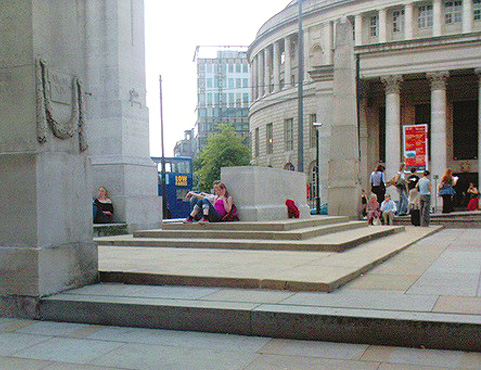The War Memorial in St Peter’s Square, Manchester has had problems for a few years now. The construction of a Metro stop made it into an overspill for the platform space. The openess of the memorial precinct appears to have undermined any sense of it being different from the surrounding pavement. The Cenotaph, a version of Lutyens’ original, struggles to register in a scene dominated by signposts, lamps and poles and the Vincent Harris buildings beyond.
It is interesting to see the informality of use especially on a hot summer day. In the picture a couple find shelter in the shadow of the Great Stone apparently indifferent to the wreath placed to commemorate the 90th anniversary of the The Battle of the Somme. The subtle connotations of altar and tomb do not register. Others sit or lie along the perimeter wall. The memorial has become a shallow, stepped landscape blasted by the sun.
In his AA Files article The Secret of the Cenotaph Andrew Crompton reflects on the genesis of the design of the original Cenotaph and Great Stone particularly the significance of geometry in their composition.
Also, have a look at The Electric Cenotaph.


Crouchback is characteristically elegaic about the use of Lutyens’s monument as impromtu street furniture. It’s pretty hard to succeed in debasing such a work, though. A favourite detail is the assymmetry of the garland adorning the date plaque at the base of the obelisk at the extreme left of the photograph. A favourite memory is the photographs of Joy Division enjoying the cenotaph’s civic amenity.
Of course ‘The Glorious Dead’ (in this particular instance) have no commercial value and therefore this landscape of stone would not in the eyes (if they have them) of the Manchester City Council deserve the sort of protection from abuse which a gimmicky scheme such as Exchange Square might muster. It is a pity that the coexistence of the sublime and the profane which Lutyens’s work achieves with such apparent lack of effort remains beyond the reach of the city centre management team, as exemplified by their installation of temporary urinals behind Tadao Ando’s wall in ‘New’ Piccadilly – anyone for ‘trickledown’ urbanism?